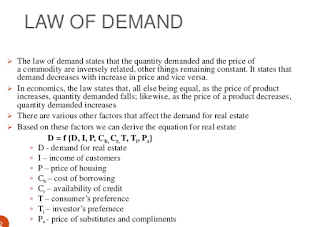 |
| law of demand |
Demand schedule tells you the exact amount that will be bought at any cost. The real life example of how it works in the demand schedule for beef in 2014.
Plans those numbers on the demand curve a chart This quantity is horizontal or x-axis, and the price is on the vertical or y-axis
If the amount purchased is changing a lot in prices, then it is called elastic demand. An example of this is ice cream. If the price goes up too much then you can easily get a different dessert.
If there is not much change in quantity, then this is called incompatible demand. An example of this is gasoline, you must buy enough to work regardless of price.
As long as "all other things remain the same, this relationship is right." This part is so important that economists used the Latin word to describe it - ceteris paribus. "All other things" which are required to be equal under ceteris paribus, these are the other determinants of the demand. These are the prices of related goods or services, income, taste or preferences and expectations. For the total demand, the number of buyers in the market is also a determinant.
If other determinants change, then consumers will buy more or less of the product, even if the price remains the same. That is called a change in demand curve
Explained law of demand
For example, airlines want to lower the prices when they continue to be profitable in oil prices, they do not even want to cut the flights
Instead, they buy more fuel-efficient aircraft, fill all seats, and change operations to improve efficiency. Consequently, they increased gallons per seat-mile from 55 to 2005, which has turned 60 in 2011. The law of demand states that the decrease in the amount of fuel required by airlines dropped as prices increases.
Of course, all other things were not the same during this period. In fact, the demand for jet fuel was reduced because the income of the airlines also declined at the same time. The 2008 global financial crisis meant that passengers cut their demand for air travel. Airlines's expectations about the cost of jet fuel also changed. They realized that it would continue to grow for a long time. The other two determinants of the airline's demand for jet fuel were banned. They could not go on any other fuel, and their desire or desire to use jet fuel could not be changed. (Source: "High Airline Jet Fuel Cost Prost Cost-Savings Measures," EIA.)
Whenever retailers offer sales, they use the law of demand every time. In the short term, all other things are the same. This is the reason that sales are usually very successful in driving demand. Shoppers advertently respond to the price drop, this works especially during large-scale holiday sales, such as Black Friday and Cyber Monday.
The Law of Demand and the Business Cycle
Politicians and central bankers understand the law of demand very well The mandate of the Federal Reserve is to curb inflation while reducing unemployment. During the phase of expansion of the business cycle, the Fed tries to reduce the demand for all goods and services by increasing the price of everything. It deals with contractionary monetary policy, it has increased the rate of money raised, thereby increasing interest rates on loans and mortgages. To increase the prices on it, first loan, then everything is bought with a loan, and finally everything else
Of course, when prices rise, inflation increases, it is not always a bad thing that the Fed has an inflation target of 2 percent, it expects prices to rise 2 percent a year, the demand increases because people know that things Only spend next year
Therefore, they can buy it now ceteris paribus.
During the downturn or during the contraction phase of the business cycle, policy makers have a poor problem. They have to encourage demand when workers are losing jobs and homes, and they have less income and wealth, expansive monetary policy reduces interest rates, which reduces the cost of everything if the recession is bad enough. It does not reduce the cost to offset low income
In that case, there is a need for fiscal policy. The federal government usually starts spending money on making public work, increasing the benefits of unemployment, and cutting taxes. This increases the deficit because the income of the government is less by taxes. After restoring trust and demand, the tax receipts in the deficit will fall in the form of an increase.
0 comments:
Post a Comment